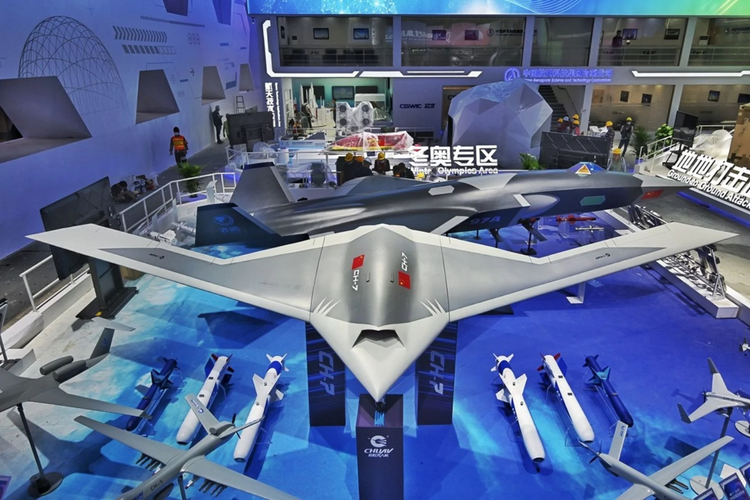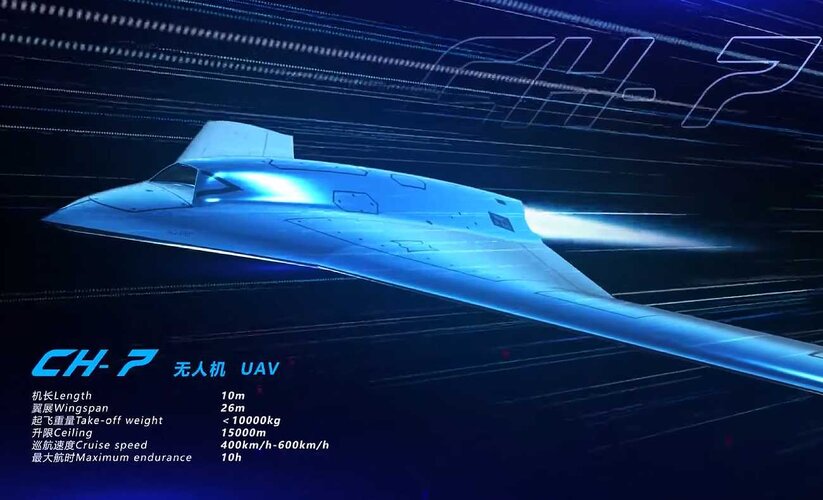- Joined
- 27 December 2005
- Messages
- 16,922
- Reaction score
- 21,778
Wang Yongzhi, the technical expert of the Rainbow series, told the Global Times on Monday in an exclusive interview that the Caihong-7 is a high-altitude, subsonic, and stealth drone, which has a maximum takeoff weight of 13 tons and a wingspan of 22 meters. Rainbow-7 is currently in the design stage.
The rainbow series of unmanned aerial vehicles (UAV) can perform fire suppression, electronic warfare, reconnaissance, long-term warning and other tasks on the battlefield.
The CH-7 was developed by China Aerospace Science and Technology Corporation (CASC).
Its development makes China among a handful of companies to develop high-altitude, high-speed and stealth drones worldwide. The CH-7 is competing with the US RQ-180 and X-47B, Wang noted.
The Rainbow-7 can perform tasks together with manned aircraft, including four generations of stealth fighters. The UAV would perform pre-reconnaissance and surveillance missions, using its stealth capabilities and long-haul performance, together with manned aircraft and early warning aircraft, Wang said.
With a maximum takeoff weight of 13 tons, it can mount more advanced reconnaissance payloads and more combat weapons, performing on-demand missions on high-value targets.
Wang believes that high altitude, high speed and invisibility will be the trend of high-end drone development.
According to Wang, the CH-7 will continue to inherit the advantages of the CH-4 and CH-5 - high reliability, high attendance, universal ground station and full automatic control technology - but will also adopt technology of previous models that have not been used.
Unlike the CH-3, CH-4, and CH-5 which adopted the traditional unmanned structure, the CH-7 adopts a flying wing configuration with typical stealth characteristics. With the breakthrough in aerodynamic designs, the flight control also adapted a tailless wing configuration. In terms of power, it uses a turbofan engine that can fly at high altitudes and high speed, Wang told the Global Times.
To achieve a stealth performance, Wang noted that the CH-7 will also have an invisible shape and coated wave-absorbing material.
The CH-7 is mainly meant to meet the development needs of China's own related equipment. If it conforms to the national export policy, it can also be sold to help improve the defenses of other countries, Wang said.
The UAV has the ability to be modified for use on carriers, Wang noted, adding if it is equipped with radar, it would improve China's ability to safeguard maritime rights and interests.



I am sorry but this thing wouldn't weight 10t in any configuration. Without the wings. perhaps.
I am sorry but this thing wouldn't weight 10t in any configuration. Without the wings. perhaps.
Then that what we see is a simple a mockup, OK.

Look closely how the wing flexes on the runway asperities. There is no way that it can sustain the weight of an a/c with a 10t MTOGW.
Allegedly the CH-7 prototype
Look at the Boeing Ghost Bat clone behind the wing, again, copy, copy, copy.
Focus: How China is Preparing for the New Drone Warfare
Focus: China's Strategic Preparations for Next-Generation Drone Warfarearmyrecognition.com
View attachment 738083
Probably where they got it from.Looks almost identical to Aviation Week's "RQ-180" concept from 2013
You'd read Sensorcraft thread and take a look on NGC SC concept development three. At least one other NGC SC configuration (final) was carefully studied by Chinese.Which is curious. How is it possible that a real plane is so similar to artistic rendering from a news source, from a decade ago?!?
Probably where they got it from.
Which is curious. How is it possible that a real plane is so similar to artistic rendering from a news source, from a decade ago?!?
A) the ch7 plane was modeled after the graphic from said article
B) graphic from the article wasn't pure nonsense but the author actually saw some real life secret designs to base their work on.
C) it's coincidence.
There are only so many flying wing configurations out there.
There are a lot of flying wing configurations, especially for this mission, that are not workable.
The degree which this design mimics the Aviation Week concept though is surprising.
Maybe soon we will see a country produce a full sized Testors F-19!
Even the CH-7 did not always have this exact geometry.
From memory it first showed up in Zhuhai 2018 with a wingspan of 22m and a length of 10m. Overall the years it's wingspan has grown to 27m while keeping the same length
Sounds like it’s been taking some little blue pills… maybe performance anxiety?
Not sure. It's not a particularly important program so there hasn't been much rumours about its development course, but it seems like they pursued some design revisions
It’s almost like some committee was dictating the design, not by engineer but by politics or optics!
*orders sensorcraft from wish*
Usually revisions of design should be assumed to be due to requirements or engineering needs, the idea that they were specifically wanting to redesign an aircraft to superficially look like old RQ-180 art is difficult to entertain.
Their equivalent of sensorcraft would be more the Divine Eagle UAV.
The CH-7 is straight out of the Aviation Week concept, which is derived from the sensor craft studies.
My bet is that they may build a few of them but operate them at medium altitude not high altitude, and all of the advantages of this configuration will be lost. All of the LO advantages of this configuration are lost at this size and medium altitude - facts that would be obvious to engineers rather than party officials.
Why do you think they would be operated at medium altitude rather than high altitude?
[ /quote]
Because they don’t have engines qualified to operate at that altitude , and the airframe isn’t big enough…
Because they don’t have engines qualified to operate at that altitude , and the airframe isn’t big enough…
Mounts for optional vertical tails or rather for spin recovery chute?
View attachment 747860
What altitude is that?
The ceiling of CH-7 is described as 16,000m, and I'm pretty sure they have engines that are viable for that altitude.
The CH-7 configuration is almost identical to a SensorCraft configuration that itself was based on an earlier program. The SensorCraft configuration was designed for operation at 23000m, and the earlier version was designed for even higher.
My point here is that this configuration is very clearly for those much higher altitudes. But they're not using it at those altitudes, and probably do not have the capability to do so (engines, etc). So why go with this configuration? Why not something optimized for the altitude it will actually operate at?
First, is just what kind of performance it will have at its 16,000km versus say, a higher altitude of 23,000km. There's a difference between being optimized for a higher altitude versus being unable to operate at its stated altitude (which is still rather high).
